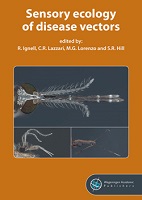Chapter 13 Sand fly sex/aggregation pheromones
| dc.contributor.author | Hamilton, J.G.C. | |
| dc.date.accessioned | 2023-07-12T12:11:23Z | |
| dc.date.available | 2023-07-12T12:11:23Z | |
| dc.date.issued | 2022 | |
| dc.identifier.uri | https://library.oapen.org/handle/20.500.12657/63875 | |
| dc.description.abstract | Sand flies are an ancient group of Diptera estimated to contain 1000 species. Approximately 70 of these transmit pathogens (viruses, bacteria and protists), which cause human and animal diseases. The most important are the Leishmania parasites, transmitted to humans and animals, during blood feeding by female sand flies, and which cause diseases that can be fatal or disfiguring. Sand flies are known to use volatile chemicals produced by plants to locate sugar meals, host odours to locate a blood meal, and chemicals from decaying vegetation and other sources to identify oviposition sites. In a limited number of cases, male sand flies also produce volatile chemicals (sex/aggregation pheromones) that are attractive to females and other males. The presence of sex/aggregation pheromones is well documented in Lutzomyia longipalpis sensu lato, the South American vector of Leishmania infantum, in which they were first identified 40 years ago. During this time, a range of behavioural and chemical methodologies have been applied to their study in the laboratory and the field. The presence of sex/aggregation pheromones has also been suggested in a small number of other New and Old-World vectors, but the evidence is incomplete, as it is either solely chemical, i.e. without supporting behavioural evidence or behavioural evidence is available, but there is no supporting chemical evidence. Within the Lu. longipalpis s.l. species complex, the sex/aggregation pheromones provide a taxonomic guide to the members of the complex. There are four different known chemical types (five members of the complex), and one of these, the most geographically widespread, has been synthesised in bulk quantity. The synthetic pheromone, co-located with insecticide, has been shown to significantly reduce numbers of sand flies, and leishmania infection in dogs, the reservoir of human infection, and could significantly impact the number of human cases. | en_US |
| dc.language | English | en_US |
| dc.subject.classification | thema EDItEUR::P Mathematics and Science::PS Biology, life sciences::PSV Zoology and animal sciences | en_US |
| dc.subject.other | phlebotomines, leishmaniasis, vector control, Leishmania infantum, (S)-9-methylgermacrene- B, 3-methyl-α-himachalene, sobralene, sand fly, pheromones | en_US |
| dc.title | Chapter 13 Sand fly sex/aggregation pheromones | en_US |
| dc.type | chapter | |
| oapen.identifier.doi | 10.3920/978-90-8686-932-9_13 | en_US |
| oapen.relation.isPublishedBy | 4bf20bcf-e428-432f-9b33-947a06e551fd | en_US |
| oapen.relation.isPartOfBook | 1d00e2ae-c1a6-43ae-93a8-ef801f5d3f9a | en_US |
| oapen.relation.isFundedBy | d859fbd3-d884-4090-a0ec-baf821c9abfd | en_US |
| oapen.relation.isbn | 9789086863808 | en_US |
| oapen.collection | Wellcome | en_US |
| oapen.pages | 23 | en_US |
| oapen.place.publication | Wageningen | en_US |

